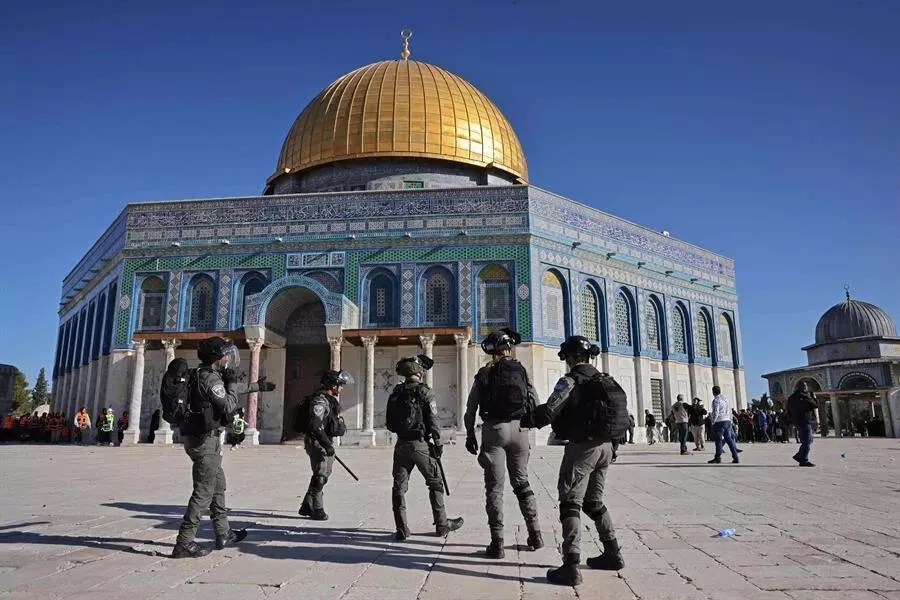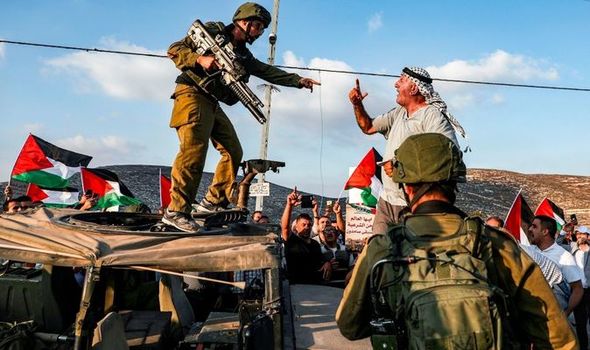
Background
The strenuous relations between Palestinians and Israelis reared its head again after Israeli police stormed the Al-Aqsa Mosque premises in East Jerusalem, as admirers gathered for early daytime prayers last month. According to Al Jazeera, Israeli police captured more than 300 Palestinians and harmed around 170 others on April 15. Al-Qibli Mosque and the Dome of the Rock are situated on a 14-hectare (35-section of land) site. Israeli police asserted they entered the site to permit visits to the sacrosanct site by a wide margin of Jews.This spot in Jerusalem’s Old City has turned into a hotbed of contention among Palestinians and Israeli officers and fanatic gatherings for a really long time, and is at the focal point of opponent verifiable cases.
One of Jerusalem’s most notable tourist spots is the Al-Aqsa Mosque. The area in Jerusalem’s Old City is sacred and important to Christians, Jews, and Muslims. The Old City of Jerusalem and its monuments have been assigned as a World Heritage Site by the United Nations Educational, Scientific, and Cultural Organization (UNESCO). The compound of mosques is the groundwork of the debate among Israel and Palestine (Judaism and Islam). The Temple Complex is the consecrated spot in Judaism, while the Al-Aqsa Mosque is among Islam’s most cherished locations. In Judaism, the Temple Complex is the holiest area. The Dome of the Rock toward the northern side and the Al-Aqsa Mosque towards the south are situated on the Temple Mount, which is a walled complex inside Jerusalem’s Old City. Its Western Wall, a remnant of the Second Temple and the hallowed site in Judaism, is found southwest of the Temple Complex.
Two scriptural sanctuaries, as per Jews, were initially arranged there. The primary sanctuary was wrecked by Babylonians in 587 BC, and the second was destroyed by Romans in 70 CE, as indicated by the Bible. The Western Wall, otherwise called the Buraq Wall by Muslims, remains on the site. The divider is viewed by Jews as a continuation of the Holy Site. They accept the Ark of the Covenant, the chest containing the stone tablets whereupon Ten Commandments were written, is kept in the sanctuary’s inward sanctum. In Judaism, it is likewise viewed as where God gathered residue to make Adam. Al-Aqsa has two distinct implications in Arabic: “the farthest,” which connects with its area corresponding to Mecca as portrayed in the Quran, and “a definitive,” which relates to its renown among Muslims. Following Mecca’s Masjid-al-Haram and Medina’s Masjid-a-Nabawi, the mosque is Islam’s third holiest area. The Dome of the Rock, which was finished in 691 CE during the Umayyad Caliphate, is situated inside the complex.
The Foundation Stone, a stone out of which Muslims consider the Prophet rose to paradise, is housed inside the design. The Dome of the Rock is professed to safeguard the stone from which Muhammad rose actually.Muslims likewise accept that it was at this area that Prophet Muhammad drove his different prophets in supplication on a supernatural night journey from Mecca to Jerusalem. During the long stretch of Ramadan, the mosque offers everyday prayers and huge social events for Friday supplications, which are joined by Palestinians, Arabs from Jerusalem, and Muslims from by and large around the globe. Muslims have represented the entry to the Aqsa complex since Arabs took Jerusalem from the Crusaders in 1187. The United Nations planned to divide Palestine in 1947, which was then controlled by the British, into two states: one for Jews and one more for Palestinians. On account of its strict significance, East Jerusalem, which holds al-Aqsa mosque, was to be regulated by the United Nations.
The Arab-Israeli conflict

The principal Arab-Israeli conflict began in 1948, not long after the state of Israel took form. Soon after its formation, Israel vanquished 78% of the region along with the excess areas of the West Bank, East Jerusalem, and Gaza falling under Egyptian and Jordanian rule. During the 1967 Six-Day War, Israel took East Jerusalem from Jordan when an alliance of Arab states including Jordan, Syria, and Egypt declared war on the former. Following the outcome of the battle which favored Israel, Jordan’s Waqf Ministry, which had beforehand administered the al-Aqsa Mosque, declined to continue to administer the mosque. The mosque and the northern pieces of the complex, alluded as Haram al-Sharif, were given to the Islamic Waqf Trust, an independent organization under the Israeli government. Inside the mosque’s limits, Israeli security administration keeps a watch throughout.
Visitors while heading to the Muslim sacred towns of Mecca and Medina frequently stop in Jerusalem to visit Al-Aqsa before the area’s contemporary boundaries were drawn up. Many enthusiasts actually run to the mosque on Fridays, and Muslim festivals bring large groups. Israel has kept on adding provinces in East Jerusalem since its occupation. Israel sees the whole city as its “bound together, never-ending capital,” while Palestinian authorities across the political spectrum have expressed that there will be no trade-off over the planned Palestinian state and East Jerusalem must be assigned as its capital.
Recent History
The struggles this month are related partially to the Islamic heavenly month of Ramadan that started on April 2 and the Jewish celebration of Passover which initiated on Friday, April 15, and went on until April 23. The significant impetus, however, was a succession of road assaults against Israelis in late March, supposedly by Palestinian and Arab assailants. On March 29, a Palestinian shooter fired on Israelis in Jerusalem, killing almost five people, as per Israeli media.This was the third such assault episode that week. Two Israeli security officials were killed in a shootout in the Israeli town of Hadera on March 27. Earlier, on March 22, an attacker apparently smashed a vehicle and wounded four Israelis. Following the assaults, Israeli police were on guard, and pressure on them increased on April 15 as Palestinian Muslims gathered in the complex for Friday prayers.
Many Palestinians tossed fireworks and rocks at Israeli police and the Western Wall, inciting the last option to answer with elastic slugs, shock projectiles, and implement charges, purportedly to scatter the protesters. 152 Palestinians were harmed in the conflicts, while hundreds were detained by police. Hamas asked that the police discharge the prisoners and that Jews abstain from making “provocative visits” to Al-Aqsa. Similar conflicts occured on April 17, injuring 17 Palestinians. The Israeli police say they entered the site to help with a normal visit by Jews to the Temple Mount. Palestinians had purportedly gathered stones and raised impediments in anticipation of turmoil, as per police. Following these episodes, Israeli police blamed Palestinians for “contaminating and despoiling” the sacred spot, while Palestinians asserted Israel was trying to segment the blessed site.
Al-Aqsa is known as the “most delicate spot in the Israeli-Palestinian struggle” and it has been the mark of various conflicts and political questions. As per an article in The Conversation, in August 1969, an Australian Christian tried to torch Al-Aqsa, annihilating the generally huge and finely cut minbar – or “lectern” – of Saladin, a valued thing of Islamic craftsmanship. In 1990, the Holy Mount Believers, an Orthodox Jewish development, declared that the Dome of the Rock would be destroyed and an establishment for the Third Temple would be laid in its stead. This started fights wherein Israeli forces allegedly killed 20 Palestinians.
Ariel Sharon, the former Israeli Prime Minister, visited the sacred site in September 2000, accompanied by 1,000 cops. This set off the Second Intifada, a Palestinian uprising that killed more than 3,000 Palestinians and 1,000 Israelis. In 2014, Israeli specialists obstructed passage to Al-Aqsa after such an intifada on the calls on the conservative rabbi Yehuda Glick. In order to remember the 50th commemoration of Israel’s extension of East Jerusalem, the Israeli government assembled its week after week meeting in burrows underneath al-Aqsa Mosque in May 2017, a move that incensed Palestinians. Subsequent to providing Israel a request to empty security faculty from the al-Aqsa site, Hamas sent off rockets into Israel from Gaza in May 2021. The cutoff time showed up following viciousness that left 300 individuals harmed around the sacred site. Israeli police entered the intricate complex, utilizing daze explosives and poisonous gas to scatter the non–conformists. The clashes continue to this day as neither side is ready to back-down.
(Dharani is an aspiring Filmmaker and a writer who works as an Assistant director in the Tamil film industry. She tweets at @PugalDharani. Her Instagram ID is https://www.instagram.com/dharani.pugal/)

Well Balanced piece Dharani. Promising start. All the best.
A well articulated piece with a slice of history and the manifestation of greed, territorial usurping and accession leading to repeated conflicts and incursions in this holy land brought out vividly by you Dharani!
We are living in an age of territoralized world where every country is vying to get a piece of the other country’s cake. The divisions of the planet as a result of dominance, geopolitical gains, richness in natural resources and its ruthless plunder, oneupmanship of the developed nations, well this list is almost endless and we are caught in this chakravyuha or labyrinth of divisiveness.
Well written Dharani All the Best